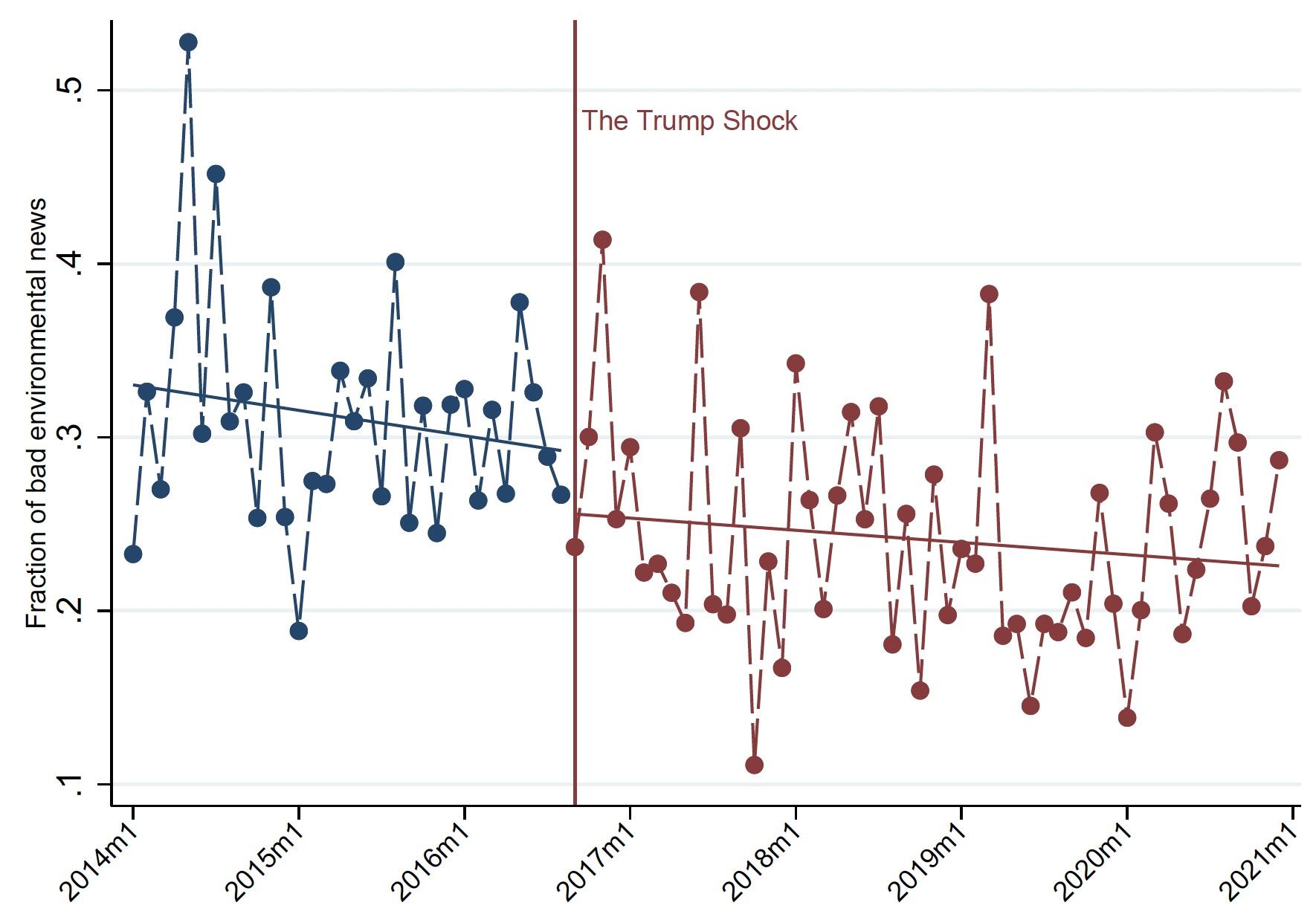Banks’ management of climate risks is a key concern to regulators and supervisors. The ECB (2022) has made climate risk management a supervisory priority for the next years. Likewise, Jerome H. Powell (2021), chair of the Federal Reserve of the US, highlights the importance of integrating risks related to climate change into banks’ risk management frameworks.
Climate risks consist of physical and transition risks. Physical risk stems from the direct effects of climatic events such as natural disasters, abnormal temperatures, or rising sea levels. Transition risk refers to the risk inherent in changing strategies, policies, or investments as society aims to reduce its reliance on carbon. Transition risk is most relevant for carbon-intensive firms, as climate regulations may lead to more stranded assets for these firms.
Previous studies find that banks account for climate physical risk in their pricing decisions or credit supply (Murfin and Spiegel 2020, Nguyen et al. 2022). In contrast, evidence on how banks manage climate transition risk is still limited and mixed, partially because it is challenging to measure transition risk when the implied costs depend on the highly uncertain pace of transition. For example, Claessens et al. (2022) argue that it is unrealistic to expect banks to finance the green transition in the absence of adequate environmental policies. Another strand of literature shows that banks account for transition risk in credit supply and loan pricing decisions (Degryse et al. 2023, Beyene et al. 2018) and loan volume (Kacperczyk and Peydro 2021, Mueller and Sfrappini 2022, Ivanov et al. 2022).
Securitisation as a tool to shift climate transition risk away
In a recent project, we show that banks can also manage climate transition risks by securitising loans to less-regulated entities in secondary markets (Mueller et al. 2022). We argue that the use of securitisation as a risk-shifting tool may weaken the effectiveness of bank climate policies, especially when securitisation allows banks to offer a carbon discount on loans given to carbon-intensive firms. Furthermore, while banks can also shift risk via other channels such as the use of credit derivatives, the size of corporate loan securitisation markets is massive and growing fast, reaching more than $1.3 trillion worldwide in 2019, making it a first-order focus of investigation.
To answer our research questions, we combine data on securitisation with borrowers’ carbon emission intensities in the US between 2013 and 2019. Exploiting the election of President Trump in 2016 as an exogenous shock to transition risk, we document three main findings.
First, we find strong evidence that a bank’s securitisation decision is sensitive to borrowers’ carbon footprints. Between 2013 and 2016, banks are more likely to securitise loans to shadow banking entities when borrowers’ carbon intensities are higher. This particular period is characterised by relatively high transition risk because of stricter climate regulations. For example, under the Obama administration, fuel efficiency standards were introduced in 2012, the Environmental Protection Agency Clean Power Plan was proposed in 2014 and implemented in 2015, and the US signed the Paris Agreement in 2015. Thus, our findings suggest that banks shift transition risk off the balance sheets via securitisation when transition risk is high.
In contrast, after Donald Trump’s unexpected victory in the 2016 presidential election, banks quickly adjust to lower transition risk and keep these brown loans on their balance sheets. Following previous literature (Ramelli et al. 2021, Ilhan et al. 2021), we argue that Trump’s election triggered an exogenous reduction in overall transition risk. His election represented a discontinuation of the trend of tightening climate regulations. Between 2016 and 2020, the Trump administration rolled back more than 100 environmental policies. Data from RepRisk reinforce our argument and show that after November 2016, the fraction of bad news related to firms’ environmental issues over total bad environmental, social and corporate governance (ESG) news declined sharply. This environmental-related news usually reveals the intensity of news coverage about environmental issues and can be interpreted to flag firms’ environmental risks (Duan et al. 2023).
If banks view securitisation as a tool to manage their exposure to transition risk, a decline in the risk would lead to a lower likelihood of carbon-intensive loans being securitised. Our results confirm this hypothesis and show that banks quickly adapt to lower transition risk and keep these loans in their books.
Figure 1 Fraction of bad environmental news before and after Trump’s election
Notes: This figure illustrates the percentage of bad environmental news over total environmental, social and corporate governance (ESG) news for US firms on a monthly basis between January 2014 and January 2021. The data is from RepRisk, a data provider that screens daily since 2007 over 100,000 media, stakeholder, and third-party sources as well as social media for news related to firms’ ESG practices.
Second, we find evidence that banks do not price transition risk as much if they can securitise these loans. During the period of relatively high transition risk between 2013 and 2016, banks charge brown borrowers a carbon premium of 14 basis points. However, if the loan is securitised, banks offer a discount of 5 basis points to the respective borrowers. After Trump’s election, when climate transition risk is lower, banks neither price carbon risk nor offer a lower interest rate on securitised loans with higher emission intensities. Our results are in line with a recent finding by McGowan and Nguyen (2023) who argue that banks do not price credit risk when they can securitise loans. We also highlight that banks can do so because the main loan purchasers in the secondary markets are collateralised loan obligation managers who have little incentive to price transition risk, as their compensations are not strongly related to the performance of collateralised loan obligation deals (Nadauld and Weisbach 2012).
Third, our analysis uncovers that banks that are more concerned about or more aware of environmental issues are more sensitive to changes in transition risk. They engage more in selling brown loans to third parties when transition risk is high and keep these loans on balance sheets when transition risk is lower.
Additionally, our findings are stronger for domestic US lenders because these banks are more directly affected by changes in climate policies targeting US firms. In contrast, bank size and capital do not influence the relationship between securitisation and firms’ carbon emissions.
Implications for the green transition
Understanding how banks use securitisation to manage transition risk is important for three main reasons. First, while securitisation enables banks to shift risk to loan purchasers, theories predict that it may distort lenders’ incentives to monitor because banks do not have much skin in the game compared to when they hold loans on their balance sheets (Gorton and Pennacchi 1995, Parlour and Winton 2013). One of the main arguments for bank climate policies is that banks are in a better position to finance the green transition because they can monitor their borrowers’ green investments. Thus, when banks shift transition risk away by selling brown loans to less regulated entities, they may not monitor whether their brown borrowers are well prepared for the green transition.
Second, our findings show that securitisation reduces carbon premia that banks charge brown borrowers. When carbon risk is not fully priced, firms may have little incentive to reduce carbon footprints.
Third, our results provide important insights for the design of future environmental policies directed at banks. Specifically, regulators concerned about climate risks and their potential impact on financial stability need to know how financial institutions manage these risks. When banks can reduce their risk exposure by shifting risks to third parties, the effectiveness of climate policies targeting banks may be affected.
For example, several central banks around the world such as the ECB, Banque de France, the Dutch Central Bank, and the Bank of England are either planning, conducting, or have already completed climate stress tests. In these exercises, banks estimate potential losses with various scenarios when carbon prices increase sharply (Fuchs et al. 2023). Furthermore, as of 2024, EU banks will have to produce detailed figures demonstrating how much their activities are in line with sustainability criteria set by the Green Asset Ratios. However, when banks can shift risks away, any policies that target only activities reflected in banks’ books may lead to an underestimation of the real level of exposure to climate transition risks in the financial system.
References
Beyene, W, M Delis, K de Greiff, and S Ongena (2018), “Being Stranded on the Carbon Bubble? Climate Policy Risk and the Pricing of Bank Loans”, CEPR Discussion Paper 12928.
Claessens, S, N Tarashev, and C Borio (2022), “Finance and climate change risk: Managing expectations”, VoxEU.org, 7 June.
Degryse, H, R Goncharenko, C Theunisz, and T Vadasz (2023), “When green meets green”, Journal of Corporate Finance 102355.
Duan, T, F W Li, and Q Wen (2023), “Is carbon risk priced in the cross-section of corporate bond returns?”, Journal of Financial and Quantitative Analysis, forthcoming.
ECB (2022), ECB Banking Supervision: SSM supervisory priorities for 2023–2025.
Gorton, G B, and G G Pennacchi (1995), “Banks and loan sales: Marketing non-marketable assets”, Journal of Monetary Economics 35(3): 389–411.
Fuchs, L, H Nguyen, T Nguyen, and K Schaeck (2023), “Climate stress tests, bank lending, and the transition to the carbon neutral economy”, SSRN 4427729.
Ilhan, E, Z Sautner, and G Vilkov (2021), “Carbon tail risk”, Review of Financial Studies 34(3): 1540–71.
Ivanov, I, M S Kruttli, and S W Watugala (2022), “Banking on carbon: Corporate lending and cap-and-trade policy”, SSRN 3650447.
Kacperczyk, M T, and J-L Peydro (2021), “Carbon emissions and the bank-lending channel”, CEPR Discussion Paper 16778.
McGowan, D, and H Nguyen (2023), “To securitize or to price credit risk?”, Journal of Financial and Quantitative Analysis 58(1): 289–323.
Mueller, I, H Nguyen, and T Nguyen (2022), “The color of corporate loan securitization”, SSRN 4276781.
Mueller, I, and E Sfrappini (2022), “Climate change-related regulatory risks and bank lending”, ECB Working Paper Series 2670.
Murfin, J, and M Spiegel (2020), “Is the risk of sea level rise capitalized in residential real estate?”, Review of Financial Studies 33(3): 1217–55.
Nadauld, T D, and M S Weisbach (2012), “Did securitization affect the cost of corporate debt?”, Journal of Financial Economics 105(2): 332–52.
Nguyen, D, S Ongena, S Qi, and V Sila (2022), “Climate change risk and the cost of mortgage credit”, Review of Finance 26(1): 1509–49.
Parlour, C A, and A Winton (2013), “Laying off credit risk: Loan sales versus credit default swaps”, Journal of Financial Economics 107(1): 25–45.
Powell, J H (2021), “Statement of Chair Jerome H Powell on the Financial Stability Oversight Council’s (FSOC) Report on climate-related financial risk”, Board of Governors of the Federal Reserve System, press release, 21 October.
Ramelli, S, A F Wagner, R J Zeckhauser, and A Ziegler (2021), “Investor rewards to climate responsibility: Stock-price responses to the opposite shocks of the 2016 and 2020 US elections”, Review of Corporate Finance Studies 10(4): 748–87.







